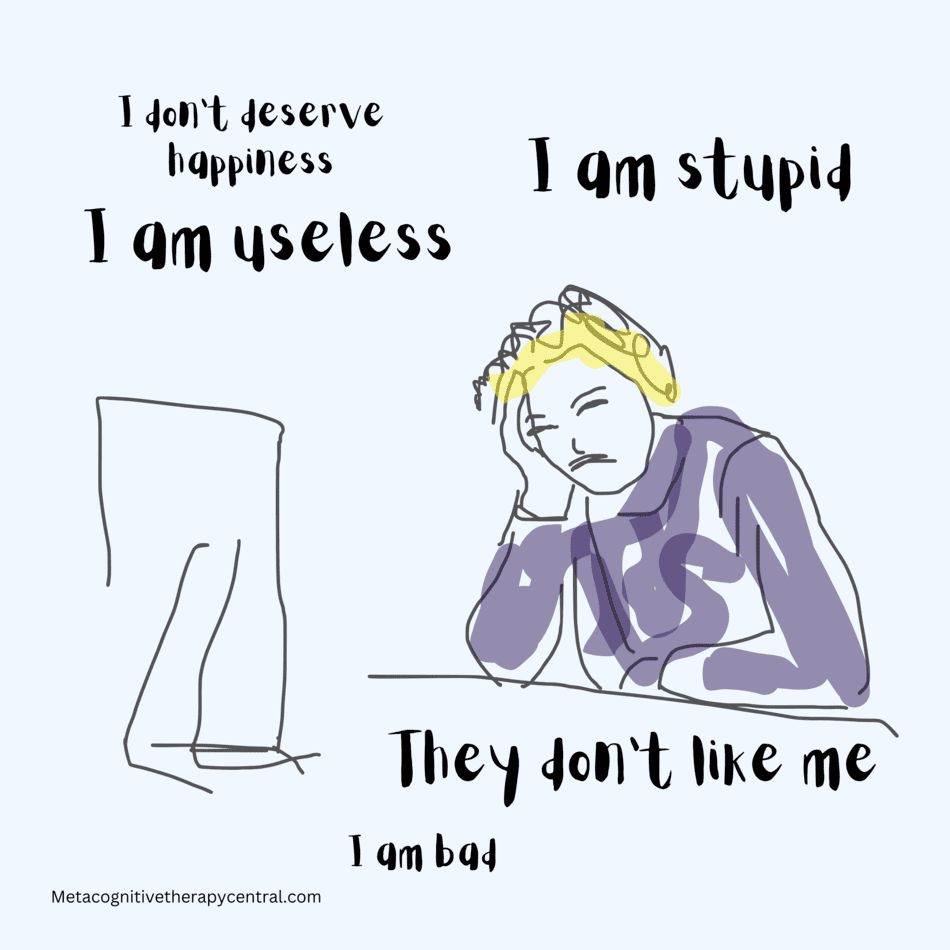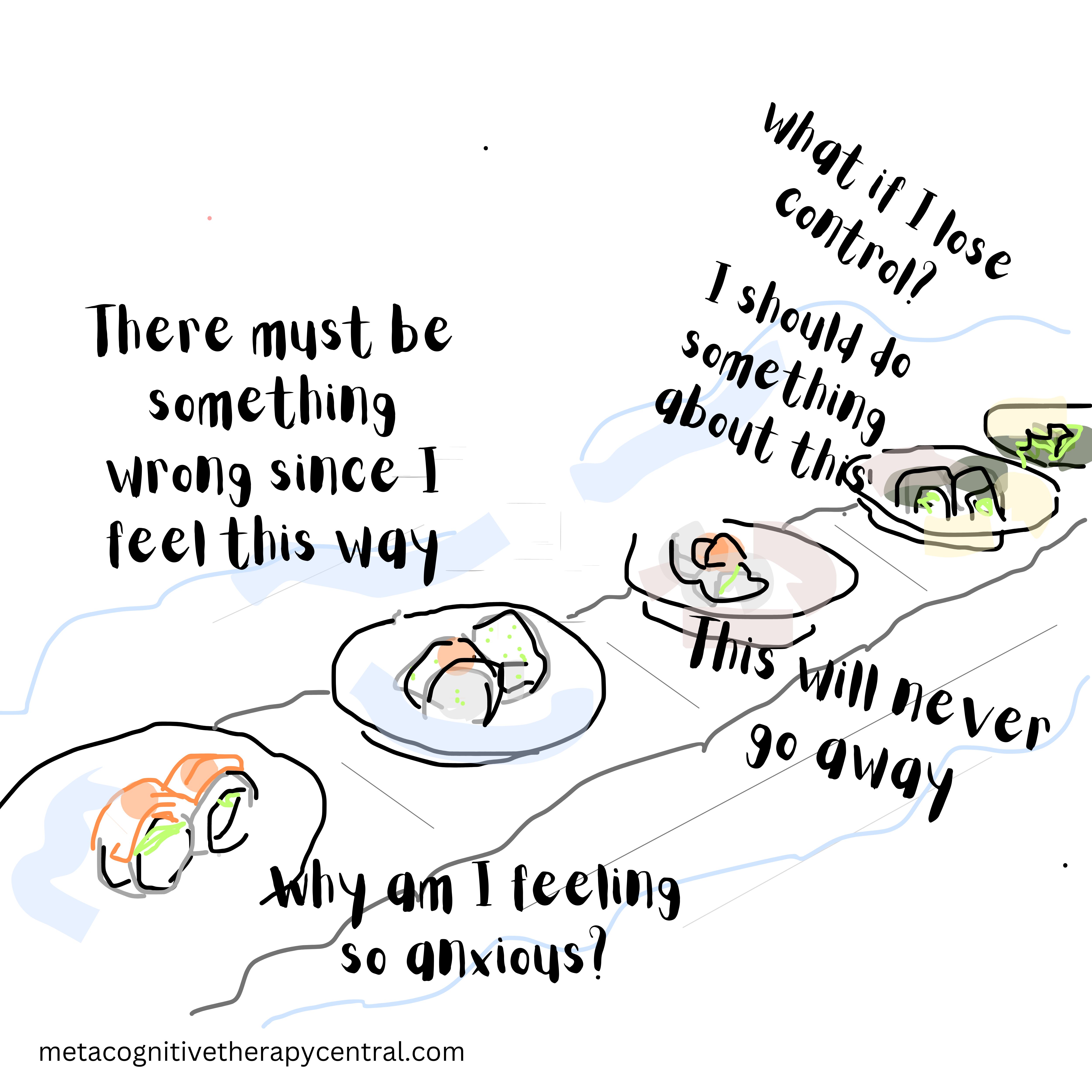
As metacognitive therapy is gaining popularity, the term “detached mindfulness” gets tossed around a lot. Some view it as a miracle tool, while others misuse it to get rid of negative thoughts.
Detached mindfulness means being aware of a thought in the mind and doing nothing with it. Mindfulness means being aware. Detached means not grabbing the thought, answering it, or pushing it away. Basically, detached mindfulness means to co-exist with thoughts as one would co-exist with background noise (1).
Detached mindfulness is not, however, a thought control strategy, and it shouldn’t be used to get rid of discomfort. Detached mindfulness is not really even a tool.
Now that it is out of the way let’s look into what detached mindfulness is, what it can do, and how you should use it. We will also highlight what detached mindfulness isn’t and how you shouldn’t use it.
What is detached mindfulness?
Detached mindfulness is a mind strategy that is the opposite of rumination, worry, and thought control. Detached mindfulness means leaving thoughts alone in your mind without pushing them away. Another important part of detached mindfulness is to view thoughts for what they are: brief inner events that aren’t facts.
Since negative thoughts and feelings can trigger overthinking (and overthinking is the reason behind anxiety and depression), detached mindfulness is a different way to relate to thoughts and feelings that counteracts overthinking.
Detached mindfulness has two features:
1) To take a step back from thoughts
2) To separate yourself from your thoughts and view thoughts as passing events in the mind that you don’t need to assign meaning to.
Detached mindfulness means doing nothing to thoughts so that the mind can regulate itself from negative emotions
To apply detached mindfulness to a negative thought, you should allow the presence of that thought in your mind and passively watch it. You may find that nothing happens to the thought, or maybe it transforms into another thought. No matter what happens, just watch that thought without influencing it in any way.
Detached mindfulness means letting your mind roam freely without interfering with thoughts, feelings, and sensations.
When you practice detached mindfulness correctly, you don’t feel like you are doing much or spending too much mental effort. In fact, if you feel slightly lazy, you are doing detached mindfulness right.

How is detached mindfulness used in therapy?
In Metacognitive therapy, detached mindfulness is used to reduce rumination and worry and to challenge metacognitive beliefs about rumination/worry.
Rumination and worry are, according to Metacognitive therapy, the reason why we feel anxious, sad, and stressed for longer periods of time, and the major reasons behind why we develop emotional disorders like anxiety.
Metacognitive beliefs are false ideas we may have about how our thinking works. For example, detached mindfulness is used in therapy to challenge the belief I have no control over my worrying.
By applying detached mindfulness to negative thoughts that trigger worrying (for example, “What if I start to panic“), you learn that worrying is not something that happens automatically. Worrying is something you choose to do. But instead of worrying you can leave the trigger thought alone (apply DM) and move on with your day.
In metacognitive therapy, detached mindfulness is used for the following reasons:
- An anti-thought control strategy. Thought control means ruminating, worrying, and suppressing thoughts. Detached mindfulness is therefore used as an alternative strategy to rumination, worry, and thought suppression.
- To challenge metacognitive beliefs. Metacognitive beliefs make us worry and ruminate about negative thoughts. Metacognitive beliefs also change our relationship to negative or intrusive thoughts, so that we start to believe that thoughts are dangerous. It is therefore important that false metacognitive beliefs are challenged. Unchanged metacognitive beliefs keep us locked in the rumination/worry cycle, which is why we develop psychological problems.
I once had a client who constantly worried about her husband cheating on her, causing her intense anxiety. Despite believing in her husband’s loyalty, thoughts like “He’s out with someone else” overwhelmed her. To address this, she learned detached mindfulness as an alternative to worrying. When these thoughts came up, she let them be without engaging with them. Although still uncomfortable, this approach helped her view her thoughts as less important. Over time, she became less anxious and more confident in her ability to stop worrying about her thoughts.
What is the goal of detached mindfulness in therapy?
The goal of detached mindfulness is to do as little as possible to internal events (thoughts, feelings, memories, and sensations). The less you try to get rid of negative thoughts, the better. The less time you spend overthinking (worrying, analyzing, and ruminating), the more you will find yourself in a detached mindfulness state.
When my clients come to therapy, they worry and ruminate a lot, and they don’t believe in their ability to stop. They have beliefs about rumination and worry being uncontrollable (I can’t stop worrying, My rumination is out of control).
In Metacognitive therapy, you learn to use detached mindfulness whenever you have triggering thoughts. Applying detached mindfulness to 70-80% of your trigger thoughts is the end goal and the fastest way to overcome anxiety and depression.
When my clients discover that they are able to stop worrying about a negative thought, their metacognitive beliefs slowly change from:
I can’t stop worrying/ruminating to I am in full control of my thinking
This change in metacognitive beliefs is important to recover from mental illness. Changed metacognitive beliefs will also help stop future overthinking episodes and setbacks. All this is due to practicing detached mindfulness.

How a therapist will teach you detached mindfulness
In the beginning of a Metacognitive therapy treatment, your therapist will ask you how much time you spend thinking about your problems (whether real or imagined problems).
Next, she will help you identify the thoughts that trigger your worrying/rumination. These thoughts are called trigger thoughts.
Then she will present detached mindfulness as a better strategy to help you overcome the anxiety or sadness that’s caused by ruminating/worrying about your problems.
Because detached mindfulness (the idea of doing nothing) can be a little too abstract to grasp, she will illustrate this with the help of different metaphors, for example:
Detached mindfulness is like watching a movie inside your mind without participating in it
Detached mindfulness is like not getting on the worry train every time a negative thought pops up in your mind
You will typically start practicing detached mindfulness in the first or second session of therapy, and once you master using it on neutral thoughts, your therapist will encourage you to start practicing with trigger thoughts to help you overcome anxiety/depression/OCD.

What is not detached mindfulness?
Detached mindfulness is not a tool for thought control, and it shouldn’t be used to get rid of discomfort.
| Detached mindfulness is | Detached mindfulness is not |
| doing nothing to whatever you experience | a tool to get rid of negative thoughts |
| doing nothing despite feeling anxious/sad/etc. | a tool to make unwanted emotions to go away |
| to let thoughts come and go as often as they like | a tool to feel calm and relaxed |
| to allow negative thoughts/emotions exist in the mind | a tool to get an empty mind |
| a passive strategy | a mindfulness technique |
| an alternative to doing something with unwanted thoughts/feelings | an active strategy |
(in case you are getting confused, detached mindfulness is a do-noting strategy)
Detached mindfulness is doing nothing (except from moving on with your day)
If you use detached mindfulness with the purpose of pushing discomfort away, you will end up feeling even more discomfort. This is because you prevent the mind’s natural self-regulation (1).
It is similar to not trying to think of a giraffe. You can’t. Thought control is a counterproductive strategy, and using detached mindfulness as a thought control strategy will eventually backfire.
Although it sounds confusing, it’s important not to overthink detached mindfulness. It is after all, a simple strategy that you use on a daily basis without even noticing.
For example, you apply detached mindfulness to many of your neutral or positive thoughts (oh, it’s sunny outside. Here are my keys. He looks good. It’s a lille cold here).
| Detached mindfulness used incorrectly | Detached mindfulness used correctly |
| Tina felt overwhelmed after a stressful day at work. She kept having thoughts like “Did I do an okay job at the meeting this morning? Does my boss think so too? What if everybody thinks that I am doing a bad job?” She felt restless and unable to calm down. Tina had read online that using detached mindfulness was helpful so she imagined that her thoughts were clouds in the sky. At first, it felt like she was able to relax a little but soon her thoughts came back and she tried even harder to imagine the clouds moving faster to push her thoughts away. Whenever she succeeded to push a thought out of her mind, she started monitoring her mind to make sure that the thought was gone for good. Eventually, Tina felt exhausted from constantly paying attention to her thoughts and did not feel any better. She then decided to cancel her social plans for the night and distract herself with a movie to calm her mind. | Jon was feeling anxious and panicky. As he was about to leave his flat to go to a party, he noticed his heart beating faster and had the thought “What if I have a heart attack?” Jon recognized that this was a trigger thought and that he shouldn’t start worrying about it, because it would make his anxiety worse. He, therefore, decided to leave the thought alone in his mind and head out to the party despite feeling anxious. On the way, he focused his attention away from his symptoms and made sure to focus on having nice conversations at the party. A few hours later, Jon noticed that he hadn’t paid attention to his symptoms at all and that he had had a great evening. |

How to practice detached mindfulness
If you suffer from excessive overthinking like worry and rumination, you will benefit from reducing it so that you can feel better emotionally. Identify your triggers for ruminating/worrying (what thoughts do you usually start worrying about?) and use the below instructions consistently.
NOTE: The guidelines in this post will not substitute a Metacognitive therapy treatment with a qualified therapist. If you suffer from mild to severe anxiety/depression/OCD, I recommend that you seek therapy instead.
1) Postpone rumination/worry till later
When you notice a negative thought (for example, “I don’t have the energy“), acknowledge the thought and don’t engage with it.
You can say this to yourself: “There is a trigger thought; I am not going to deal with it now or worry about it.”
Postpone worrying about the thought until a set time later in the day, where you can worry for 15-30 minutes.
It is important that you don’t try to push the thought away or try to work it out in the meantime. The goal here is not to get the negative thought out of your mind but to refrain from analyzing it until later.
You don’t have to use the worry time if you don’t want to. Most people decide in the end that they don’t need it. Some prefer to use the worry time for solving their problems. Here is how you can do that.
2) Step back from the thought
The idea here is to allow your negative thought to be there without getting caught up in it.
The next time you notice a negative thought coming up (for example, “I’m a failure“) take a step back from the thought and observe it from a distance like you would observe a painting.
As you do that, notice that you are only an observer of the thought and that you are separate from it. The thought is only a brief and passing event in your mind.
Then move on with whatever you were doing WHILE ALLOWING THE THOUGHT TO EXIST IN THE BACK OF YOUR MIND.

Detached mindfulness explained through metaphors
Here are some helpful metaphors to remind you how to practice detached mindfulness. Pick one that makes the most sense to you.
The beach ball
Imagine that your negative thought (or feeling) is a beachball that you are carrying around with you. Instead of dropping the ball or pushing it under the water, simply tug it under your arm and move on with your day.
The sushi conveyor belt
Imagine that your negative thoughts are sushi plates moving along on a conveyor belt. You simply observe the selection of plates approaching you and decide not to pick them up.
The conversation
Worrying and ruminating is basically like having a conversation inside of your head. Can you choose to stop talking?(1).
The “no comment”
Imagine that your negative thoughts are an annoying reporter that keeps asking you the same questions over and over, and you respond with a “no comment” and move on.
For more detached mindfulness metaphors, go to this post.

What can you expect from using detached mindfulness?
If you practice detached mindfulness consistently and with the right goal (to disengage from negative thoughts to reduce worrying and ruminating), you will begin to experience that
- You can reduce worry and rumination and thereby reduce anxiety and depressive symptoms
- You feel in control of what thoughts you spend your time on
- You avoid difficult situations less
- You feel lighter and more optimistic about your future
- You feel 100% in control of your mental health
- You have more mental energy to solve problems
To achieve all this, however, you need to allow your negative thoughts and emotions instead of pushing them away. You need to practice detached mindfulness with the right goal.
Can you apply detached mindfulness to emotions?
Yes, the same strategy applies to both thoughts and emotions. Usually, when experiencing an unwanted emotion, we have thoughts like “I don’t want this” or “This is too much, I can’t handle it” or “I’m gonna lose it“. Decide to leave both the emotion and the thoughts alone and move on with your day.
How to avoid using detached mindfulness with the wrong goal
People want to get rid of negative thoughts because dealing with anxiety and depression is really tough. When we discover something like detached mindfulness, our natural reaction is to use it to feel better.
Our culture often tells us that we should always be happy, and if we’re not, something’s wrong. This idea makes us intolerant of negative feelings, and we end up trying hard to push them away.
So, it makes sense that people want to use detached mindfulness to cope and get rid of these bad feelings. But the thing is, trying to kick out thoughts doesn’t work, and it might even make us feel worse.
To use detached mindfulness correctly, make sure you’re aware of why you’re doing it. If your goal is to make an unwanted thought or feeling go away, change it. Instead, focus on letting the thought or feeling be there without overthinking it.

How do I know that detached mindfulness is working?
You will know that you have applied detached mindfulness correctly when you can easily switch to something else, like different thoughts or continuing your day. But don’t keep checking for progress. Just let your mind do its thing and stay focused on your daily plans. Sometimes the same trigger thought will come back and that’s okay.
Is detached mindfulness the same as mindfulness?
No, detached mindfulness is not the same as mindfulness or meditation. There are some similarities between detached mindfulness and mindfulness meditation, such as allowing thoughts to roam freely and stepping back from thoughts.
But there are also many differences: detached mindfulness does not require attention shifting or a breathing practice (focusing on the breath), nor is detached mindfulness used to make you feel calm.
This post covers the differences between mindfulness and detached mindfulness in detail.
Summary
Here is a summary of detached mindfulness:
- Detached mindfulness is a do-nothing strategy for negative thoughts and feelings
- Detached mindfulness is an alternative to rumination, worry, and thought suppression.
- Detached mindfulness means leaving your negative thoughts alone
- Detached mindfulness shouldn’t be used to eliminate thoughts
- Detached mindfulness is not the same as mindfulness meditation
Doing nothing is doing everything – Adrian Wells, founder of Metacognitive therapy
Book a free intro session to hear how Metacognitive therapy can help you learn detached mindfulness and overcome anxiety, depression, and OCD.
References
- Wells, A. (2009). Metacognitive therapy for anxiety and depression. Guilford Press.



